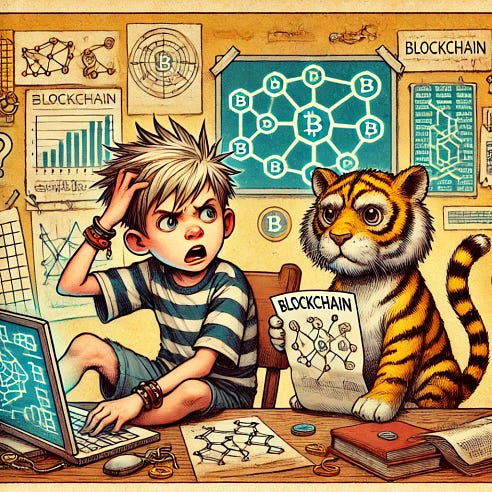You are a free subscriber to Me and the Money Printer. To upgrade to paid and receive the daily Capital Wave Report - which features our Red-Green market signals, subscribe here. Moving Money and Calling It Innovation (Or... Why Are We Doing This Again?)We have a new Rube Goldberg machine in the financial markets... and I don't understand it whatsoever...Dear Fellow Traveler: Let’s go back to 2009… A stranger walks up to you smelling like Corona Light, and says… “Hey… you… HEY… In 15 years, we're gonna rebuild the entire banking system. But in-stead-a-doin-it-with-buildins… we’re gonna do it on the internet, and without insurance, and it’ll be run by anonymous companies on tropical islands. And every transaction will be public forever. N-you-know-what? People will call this progress." You’d have hopefully forgotten that encounter (unless it happened with one of my friends, probably at CERES in Chicago… Then, you’d still be asking about it…) But here we are in 2025… And that drunk guy’s prediction would be exactly what we did… We took everything wrong with traditional finance, added surveillance, removed protection, multiplied the fees, and called it innovation. We created “stablecoins…” I've spent three years trying to understand why anyone wants stablecoins. The only answer I have to this keeps coming back… People don't want it. They now need it. Because we broke everything else first. The $12 Billion Annual Skim Nobody Talks AboutLet’s do the math of whatever we’re calling this little insane experiment in fiscal repression… Start there… Current 3-month T-bills yield around 4.15%, according to U.S. Treasury data. Stablecoins pay exactly zero yield. With a total stablecoin market cap of approximately $283 billion, according to DeFiLlama, we're talking about $10 billion to $14 billion annually in interest, depending on rates and supply, that should be going to users. Instead, it goes where? Tether reported multi-billion-dollar profits in 2024, according to its attestation reports. They claimed to hold over $127 billion in Treasuries by 2025, according to CoinTelegraph. That’s more debt held by the company than what South Korea has... Circle (CRCL) parks reserves in BlackRock's Circle Reserve Fund and then splits the revenue with Coinbase, which takes approximately 50%. This isn't innovation. It's rent-seeking. It's an extraction. It's reaching into another man's pocket instead of building something useful. It's like a savings account that forgot the savings part. Banks at least pretend to provide services for their net interest margin. They have branches where you can complain in person, ATMs that eat your card, customer service that puts you on hold, but most importantly, FDIC insurance. Stablecoin issuers? They hold your money, earn the interest, and give you nothing but counterparty risk. Oh, and that GENIUS Act that passed in July 2025? According to Congressional records, it prohibits stablecoin issuers from paying interest to holders, according to Morgan Lewis. Emphasis mine…
The government didn't stop the wealth transfer... they institutionalized it. At first I didn’t believe this… I think I passed out for a little while and woke up on the floor. Then I scanned the actual bill. That’s right…
What is happening? The house always wins, especially when it writes the rules and operates from a jurisdiction where the rules don't apply. When "Stable" Met Silicon Valley BankRemember, the FDIC actually saved Circle from potential collapse. When Silicon Valley Bank collapsed in March 2023, the stablecoin called USDC dropped to $0.87. Circle had $3.3 billion trapped in that bank, according to its SEC filing. However, FDIC insurance covers only $ 250,000 per depositor per bank, not per stablecoin holder. If Circle's bank failed, the FDIC would have covered Circle's $250k. Not your millions in USDC. So… just a reminder. You’re not banking… You're an unsecured creditor of an unsecured creditor. You have all the risk of a bank deposit with none of the protection. It's like buying insurance on insurance that doesn't exist. Meanwhile, traditional banks, despite their flaws, have deposit insurance, capital requirements, stress tests, and a century of regulation written into their systems following past failures. Tether? They have monthly attestations from BDO Italia. Do you trust “Geo Jean Grabinni” with your stablecoins? Luckily, he isn’t real… But you can imagine that a guy with that name works at BDO Italia… And fist pumps… A lot… The Audit That Never Was (And Never Will Be)Speaking of Tether, they've NEVER published a full, independent audit. The company, which holds over $127 billion in Treasuries… They provide monthly "attestations" - snapshots showing the money existed at 11:59 PM on the last day of the month. What happened at 12:01 AM? Nobody knows. Nor cares. Didn’t you know? We need people to own our T-Bills… Nothing prevents them from borrowing billions short-term just to pass the attestation, then returning the money. Think of it as renting a Ferrari for your dating profile photo. Tether says they're pursuing an audit. They've been saying for a while... And yet they claim to hold more Treasuries than most countries. A company that refuses to conduct a full audit claims to be one of America's largest creditors. The rebels became the establishment by rebelling hard enough. It's like a punk band becoming the establishment by writing songs about hating the establishment. The Liquidity House of CardsAccording to market data, Binance often leads in exchange volume market share. USDT dominates as the quote asset across venues. When two entities become each other's largest source of liquidity, systemic risk multiplies. Imagine two drunks leaning on each other, claiming they're standing straight. When one falls, both fall. And they're holding $283 billion of other people's money. The exit liquidity problem is worse. We have $283 billion in stablecoins, but limited fiat on- and off-ramps. If even 20% of the users tried to exit simultaneously, the system would face catastrophic stress. It's not a bank run risk... This is a mathematical certainty in search of a trigger. When this system faces stress - and the concentration suggests it will - these companies are already too big to fail. They've become systemically important through pure rent-seeking. Not by building something useful, but by inserting themselves as middlemen in a system that didn't need them. Need me to prove that? Fine. I’m not doing anything else today… The Volume Mirage (Or: How to Lie with Statistics)According to Visa and Allium's analysis, over 90% of on-chain stablecoin transaction volume is non-retail. It's market makers, bots, and arbitrage. The "trillion in volume" isn't adoption... It's algorithms trading with themselves. It's like measuring economic activity by counting how many times you move a dollar from one pocket to another. Sure, there's "volume." But it's not commerce. It's not innovation. Do you talk to yourself in front of a mirror? That’s not really a conversation either. Why are we treating stablecoin markets with such acclaim? The Apple Pay Moment That Broke My BrainI don’t understand the rationale very much. But people try to sell me on this… Imagine me in April 2022, at the Crypto Bahamas conference. Seven months before Sam Bankman-Fried would be caught playing League of Legends in his ankle monitor. I'm interviewing this crypto founder about the "revolutionary future" of digital payments. He's getting excited, hands waving, that VC-funded gleam in his eyes. "Imagine this, Garrett... one day you'll be out at dinner, and you'll be able to pay with your phone... with crypto!" I let that hang. "You mean like Apple Pay?" Ten seconds of silence. Like a dog that's been shown a magic trick. Finally, he mumbled something about decentralization and trustless systems. But we both knew. He was selling something he didn't believe in. I looked him up recently. After FTX collapsed, he pivoted to cannabis investing. Then thematic ETFs. Now he's an "AI blockchain expert." This guy is the chameleon boyfriend, liking whatever she likes… until she disappears and he needs another thing to become an expert in… The Solutions That Already Exist (But Don't Make VCs Rich)I’ve heard all of the pitches… and I still don’t fully grasp the all-in sentiment… Stablecoins enable 24/7 settlement? Okay… FedNow already offers instant payments. SEPA Instant works in Europe. We're using blockchain to solve problems that have already been solved. Financial inclusion? That’s a big one… But M-Pesa in Kenya processes more than most cryptocurrencies using flip phones. No blockchain. No seed phrases. No gas fees. It just works.... Cross-border payments at 3 am? They're expensive because banks choose to make them expensive, not because the technology doesn't exist. I sometimes feel like we’re just inventing a new alphabet because we're too lazy to teach everyone the old one and ensure it works. Every intermediary is just another hand reaching into your pocket, extracting value while adding friction. Then, I get the “Censorship resistance” pitch. The idea that unbanked people and individuals who are under political persecution will have an opportunity to succeed… Really? You think these companies are the rebels of the financial space… sticking it to the man? Tether alone has frozen over $2.5 billion in USDT since 2020. Just wait… that number is about to go UP… The Three Real Use Cases (And Why They're All Admissions of Failure)After three years, I've found exactly three legitimate uses for stablecoins, confirmed by IMF and BIS studies: 1. You live in a place where the government is nuking your currency…This, I think, is fair… If you lived in Argentina, where inflation was running at 200%, Turkey, where Erdogan believes interest rates cause inflation, or Lebanon, where banks decided your money was now theirs... then, yes, I get it. You need stablecoins because your local currency is worth less than Monopoly money and your banks are crime scenes with marble lobbies. But let's be honest about what this is. It's not innovation. It's a Band-Aid on a gunshot wound. The solution isn't stablecoins... It's competent governments. But since that's not happening, sure, hold your USDT. Just know you're trusting some guys in the Bahamas who likely paid off local officials over your local crooks. It’s not… NOT corrupt there… 2. You need 24/7 crypto trading and settlementCrypto markets never close because degeneracy never sleeps. You need stable quote currency. You need instant settlement between exchanges. You need collateral that won't drop 30% while you're in the bathroom. This is the only honest use case. No pretense about "democratizing finance" or "banking the unbanked." It's infrastructure for a 24/7 global casino. Tether handles a daily volume of over $50 billion, serving this need. At least everyone can just admit what it is. I am fine with it… but stop cloaking this as some essential system that will revolutionize finance. It’s for gamblers and speculators… I’m good with it. In the words of Frank Reynolds, “Bet on whatever…” 3. You're moving money across borders when traditional systems won't serve youMaybe it's 2 AM on Sunday, and you need to send money from Dubai to Manila. If that was your pitch, though, from Day One, I have a shit ton of questions about you… Perhaps traditional banks will not process your transaction. Maybe you're in a country with capital controls. We all know what some of these reasons are, even if we don't vocalize them. Circle reported $197 billion in USDC transactions in Q3 2023. That's real volume. But let's be clear… This works because traditional systems choose to be slow and expensive, not because the technology doesn't exist. And seriously… who the hell is sending that much money across anonymous systems. Maybe, I’m just an old-fashioned gal who doesn’t like the guys in the leather jackets, smoking cigarettes, and asking me if I want to “go fast.” If I have to send $250 million to Mozambique - assume I have a good reason to do so, and I’m willing to wait three to four days for the payment to clear… This Is Just Dumb to MeNotice what all three have in common? They're not innovations. They're workarounds for failures. Failed governments, failed banks, failed regulations. And until I understand otherwise, probably a graft as well.. We're not building the future. We're duct-taping the present. And we’re using really stupid words to describe it… What if we tried universal basic banking as a public utility? I mean instant, free ACH transfers… The technology exists; we just choose not to implement it. Would someone call that communist? Who would be impacted? Would Jamie Dimon still get his bonus? What if we had transparent fee structures where intermediaries compete on service, not extraction? What if we had deposit insurance that actually protects depositors, not just banks? What if international transfers were done at cost… not at whatever Western Union thinks they can squeeze from desperate people trying to mail money home from Queens to a territory run by warlords? We could build a financial infrastructure that serves customers, rather than extracting from them. Where value flows to users, not rent-seekers. Where innovation means making things better, faster, cheaper - not just adding blockchain to justify fees. What a concept… right? Instead, we built a digital company script and called it the future. And all the use cases that were pitched and imagined early on turned out to be just marketing for this libertarian fever dream that ultimately evolved into central planning. Congrats, crypto bros. You built the future of government-controlled finance… For free.. and now they are just taking the keys from you… The Uncomfortable Truth Nobody Wants to AdmitThe smart people defending stablecoins aren't wrong about everything. There are genuine innovations in programmable money and 24/7 settlement. But we've wrapped these advances in so much rent-seeking and regulatory arbitrage that the system becomes indefensible. The tragedy isn't that stablecoins are stupid. They solve real problems for real people. The tragedy is we're solving the wrong problems. Instead of fixing why international transfers cost 10%, we built a parallel system that might disappear overnight. Instead of providing banking to everyone, we built something that requires a PhD in computer science to use safely. Instead of making finance fair, we built a system of control where every transaction is visible but nobody is accountable. Maybe I just don’t get it… But to me, the sunk cost fallacy has become an entire industry. And users are paying for it… $10 billion to $14 billion a year, to be exact. Stay positive, Garrett Baldwin About Me and the Money Printer Me and the Money Printer is a daily publication covering the financial markets through three critical equations. We track liquidity (money in the financial system), momentum (where money is moving in the system), and insider buying (where Smart Money at companies is moving their money). Combining these elements with a deep understanding of central banking and how the global system works has allowed us to navigate financial cycles and boost our probability of success as investors and traders. This insight is based on roughly 17 years of intensive academic work at four universities, extensive collaboration with market experts, and the joy of trial and error in research. You can take a free look at our worldview and thesis right here. Disclaimer Nothing in this email should be considered personalized financial advice. While we may answer your general customer questions, we are not licensed under securities laws to guide your investment situation. Do not consider any communication between you and Florida Republic employees as financial advice. The communication in this letter is for information and educational purposes unless otherwise strictly worded as a recommendation. Model portfolios are tracked to showcase a variety of academic, fundamental, and technical tools, and insight is provided to help readers gain knowledge and experience. Readers should not trade if they cannot handle a loss and should not trade more than they can afford to lose. There are large amounts of risk in the equity markets. Consider consulting with a professional before making decisions with your money. |
Subscribe to:
Post Comments (Atom)






0 Response to "Moving Money and Calling It Innovation (Or... Why Are We Doing This Again?)"
Post a Comment